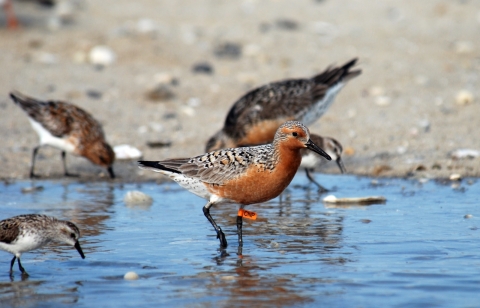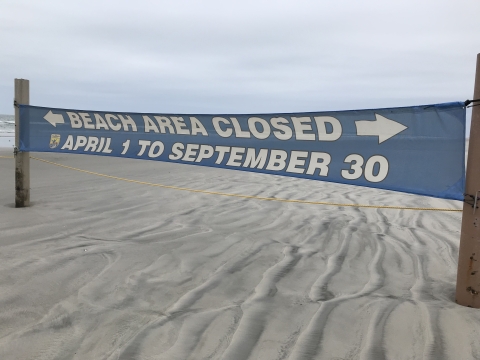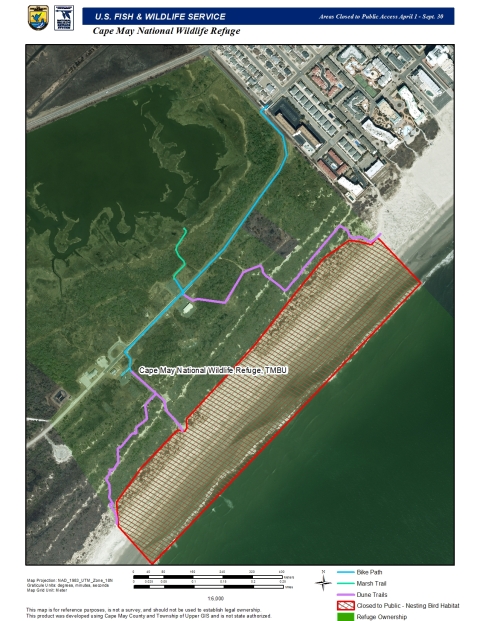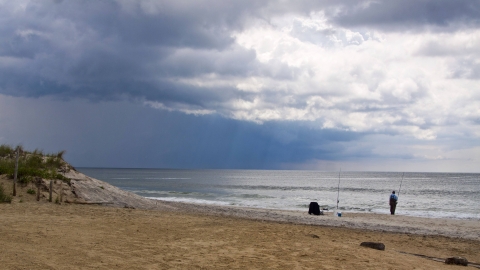States
New JerseyEcosystem
CoastalCoastal Birds
Coastal birds, or shorebirds, are a diverse group typically found along shorelines, estuaries, and other coastal areas. They are known for their long legs, specialized beaks, and unique feeding adaptations, which help them forage for insects, crustaceans, and other small invertebrates in mud or sand. Common shorebirds include the American oystercatcher, willet, and sanderling. Like all wildlife, coastal birds have specific needs:
- Habitat: Essential for breeding, migrating, and wintering.
- Food Resources: Necessary for feeding themselves and their chicks.
- Threat Mitigation: Important to minimize impacts from disturbances, predators, human development, and sea-level rise.
While coastal birds are good at selecting suitable habitats, the availability of safe areas is decreasing. This forces them to feed, nest, and rest in more vulnerable locations. As good habitats diminish, disturbances in remaining areas become increasingly critical, making it essential to address these disruptions to ensure their survival.
Disturbance
What is Disturbance?
Disturbance refers to any human activity that interrupts coastal birds' natural behaviors, such as breeding, migrating, wintering, and feeding. These disruptions can have significant impacts on these birds. Examples of disturbances include beachcombing, off-leash pets, loud noises, recreational sports, and other similar activities.
How Disturbances Affect Coastal Birds
Coastal birds experience great physical stress during migration. For instance, the rufa red knot (Calidris canutus rufa) undertakes long migratory journeys, flying around 18,000 miles round trip between their breeding grounds in the Arctic and wintering sites in South America. During these journeys, they can lose a significant amount of their body weight.
While migrating, it is crucial for these birds to regain the body weight they lost to ensure their health and reproductive success. Frequent disturbances during their stopovers can prevent them from properly foraging and resting, thus hindering their ability to recover. Even minor disturbances, such as flushing birds or causing them to land nearby, can be harmful—especially if these events happen repeatedly throughout the day as people walk along the beach.
- Stress and Energy Loss: Birds waste valuable energy every time they are disturbed, which can make it harder for them to find food and rest.
- Disruption of Breeding: Disturbances in breeding areas can lead to nest abandonment or reduced reproductive success.
- Loss of Habitat: Human activities can destroy or alter habitats, reducing essential feeding and nesting areas.
Both single and repeated disturbances can lead to the loss of individual birds, local extirpation, and broader population declines.
Sharing the Shore
Some threats to coastal birds are too large for one person to tackle alone, but collectively, our small efforts can make a significant impact. Sharing the shore helps reduce disturbances and improves conditions for birds. Here’s how you can contribute:
How You Can Always Share the Shore
- Respect signs and avoid closed areas.
- Give birds ample space to thrive while you enjoy the shore.
- Clean up and pack out all trash.
- Advocate for the protection of natural areas.
- Visit Atlantic Flyway Shorebirds to explore additional ways you can help share the shore.
How You Can Share the Shore at the Two Mile Beach Unit
- Observe the beach closure from April 1st to September 30th.
- Follow the guidance of refuge staff and stewards.
- Leave pets at home, as they can disturb coastal birds and be perceived as predators.
Other Ways to Enjoy the Refuge During the Seasonal Closure
If you plan to visit the refuge during the seasonal closure, there are still plenty of ways to enjoy Cape May National Wildlife Refuge:
- Take a Hike: Explore and photograph wildlife along the numerous refuge trails.
- Hunt and Fish: Enjoy various hunting and fishing opportunities available on the refuge. See the Visit Us page for regulations.
- Attend Programs: Participate in guided tours, educational programs, and volunteer events to learn more about wildlife.
Continuing to Reduce Disturbance After September 30th
Migration doesn’t end on September 30th! Even after the beach opens, it's crucial to remain mindful of coastal birds. Always walk around flocks rather than through them, keep noise levels down, and be cautious about your presence in feeding and nesting areas. Your ongoing efforts can ensure that these birds not only recover from their journeys but thrive in their coastal habitats.



